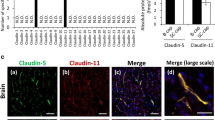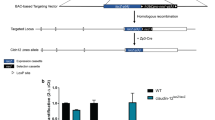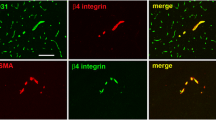Abstract
In the central nervous system (CNS) complex endothelial tight junctions (TJs) form a restrictive paracellular diffusion barrier, the blood-brain barrier (BBB). During inflammation, BBB properties are frequently lost, resulting in brain edema. To investigate whether BBB leakiness correlates with molecular changes at BBB TJs, we performed immunofluorescence stainings for TJ molecules in a mouse model of experimental autoimmune encephalomyelitis (EAE) and in human tissue with glioblastoma multiforme (GBM). In TJs of healthy CNS vessels in both mouse and man we detected occludin, ZO-1, claudin-5 and claudin-3. In EAE brain and spinal cord sections we observed the selective loss of claudin-3 immunostaining from TJs of venules surrounded by inflammatory cuffs, whereas the localization of the other TJ proteins remained unchanged. In addition, selective loss of claudin-3 immunostaining was also observed in altered cerebral microvessels of human GBM. Our data demonstrate the selective loss of claudin-3 from BBB TJs under pathological conditions such as EAE or GBM when the integrity of the BBB is compromised, and therefore suggest that claudin-3 is a central component determining the integrity of BBB TJs in vivo.


Similar content being viewed by others
References
Ando-Akatsuka Y, Saitou M, Hirase T, Kishi M, Sakakibara A, Itoh M, Yonemura S, Furuse M, Tsukita S (1996) Interspecies diversity of the occludin sequence: cDNA cloning of human, mouse, dog, and rat-kangaroo homologues. J Cell Biol 133:43–47
Bolton SJ, Anthony DC, Perry VH (1998) Loss of tight junction proteins occludin and zonula occludens-1 from cerebral vascular endothelium during neutrophil.induced blood-brain barrier breakdown in vivo. Neuroscience 86:1245–1257
Claudio L, Kress Y, Factor J, Brosnan CF (1990) Mechanisms of edema formation in experimental autoimmune encephalomyelitis. The contribution of inflammatory cells. Am J Pathol 137:1033–1045
Engelhardt B, Vestweber D, Hallmann R, Schulz M (1997) E- and P-selectin are not involved in the recruitment of inflammatory cells across the blood-brain barrier in experimental autoimmune encephalomyelitis. Blood 90:4459–4472
Engelhardt B, Laschinger M, Schulz M, Samulowitz U, Vestweber D, Hoch G (1998) The development of experimental autoimmune encephalomyelitis in the mouse requires alpha4-integrin but not alpha4beta7-integrin. J Clin Invest 102:2096–2105
Farqhuar MG, Palade. GE (1963) Junctional complexes in various epithelia. J Cell Biol 17:375–412
Faustmann PM, Dermietzel R (1985) Extravasation of polymorphonuclear leukocytes from the cerebral microvasculature. Cell Tissue Res 242:399–407
Furuse M, Hirase T, Itoh M, Nagafuchi A, Yonemura S, Tsukita S (1993) Occludin—a novel integral membrane-protein localizing at tight junctions. JCell Biol 123:1777–1788
Furuse M, Fujita K, Hiiragi T, Fujimoto K, Tsukita S (1998) Claudin-1 and -2: novel integral membrane proteins localizing at tight junctions with no sequence similarity to occludin. J Cell Biol 141:1539–1550
Furuse M, Sasaki H, Fujimoto K, Tsukita S (1998) A single gene product, claudin-1 or -2, reconstitutes tight junction strands and recruits occludin in fibroblasts. J Cell Biol 143:391–401
Furuse M, Sasaki H, Tsukita S (1999) Manner of interaction of heterogeneous claudin species within and between tight junction strands. J Cell Biol 147:891–903
Greenwood J, Howes R, Lightman S (1994) The blood-retinal barrier in experimental autoimmune uveoretinitis—leukocyte interactions and functional damage. Lab Invest 70:39–52
Gumbiner B, Simons K (1986) A functional assay for porteins involved in establishing an epithelial occluding barrier: idenification of an uvomorulin-like polypeptide. J Cell Biol 102:457–468
Kniesel U, Wolburg H (2000) Tight junctions of the blood-brain barrier. Cell Mol Neurobiol 20:57–76
Lassmann H (1983) Comparative neuropathology of chronic experimental allergic enecephalomyelitis and multiple sclerosis. Springer, Berlin Heidelberg New York
Liebner S, Kniesel. U, Kalbacher H, Wolburg H (2000) Correlation of tight junction morphology with the expression of tight junction proteins in blood-brain barrier endothelial cells. Eur J Cell Biol 79:707–717
Liebner S, Fischmann A, Rascher G, Duffner F, Grote E-H, Kalbacher H, Wolburg H (2000) Claudin-1 and claudin-5 expression and tight junction morphology are altered in blood vessels of human glioblastoma multiforme. Acta Neuropathol 100:323–331
Lippoldt A, Liebner S, Andbjer B, Kalbacher H, Wolburg H, Haller H, Fuxe K (2000) Organization of choroid plexus epithelial and endothelial cell tight junctions and regulation of claudin-1, -2 and -5 expression by protein kinase C. NeuroReport 11:1427–1431
Long DM (1970) Capillary ultrasturcture and the blood-brain barrier om human malignant brain tumors. J Neurosurg 32:127–144
Mitic LL, Van Itallie CM, Anderson JM (2000) Molecular physiology and pathophysiology of tight junctions. I. Tight junction structure and function: lessons from mutant animals and proteins. Am J Physiol 279:G250–G254
Morita K, Sasaki H, Furuse M, Tsukita S (1999) Endothelial claudin: claudin-5/TMVCF constitutes tight junction strands in endothelial cells. J Cell Biol147:185–194
Morita K, Furuse M, Fujimoto K, Tsukita S (1999) Claudin multigene family encoding four-transmembrane domain protein components of tight junction strands. Proc Natl Acad Sci USA 96:511–516
Morita K, Sasaki H, Fujimoto K, Furuse M, Tsukita S (1999) Claudin-11/OSP-based tight junctions of myelin sheaths in brain and Sertoli cells in testis. J Cell Biol 145:579–588
Rahner C, Mitic LL, Anderson JM (2001) Heterogeneity in expression and subcellular localization of claudins 2, 3, 4, and 5 in the rat liver, pancreas, and gut. Gastroenterology 120:411–422
Rascher G, Fischmann A, Kröger S, Duffner F, Grote E-H, Wolburg H (2002) Extracellular matrix and the blood-brain barrier in glioblastoma multiforme: spatial segregation of tenascin and agrin. Acta Neuropathol 104:85–91
Saitou M, Furuse M, Sasaki H, Schulzke J-D, Fromm M, Takano H, Noda T, Tsukita S (2000) Complex phenotype of mice lacking occludin, a component of tight junction strands. Mol Biol Cell 22:4131–4142
Tsukita S, Furuse M, Itoh M (1999) Structural and signalling molecules come together at tight junctions. Curr Opin Cell Biol 11:628–633
Wolburg H, Lippoldt A (2002) Tight Junctions of the blood-brain barrier: development, composition, and regulation. Vasc Pharmacol 38:323–337
Wolburg H, Neuhaus J, Kniesel U, Krauss B, Schmid EM, Öcalan M, Farrell C, Risau W (1994) Modulation of tight junction structure in blood-brain-barrier endothelial-cells—effects of tissue-culture, 2nd messengers and cocultured astrocytes. J Cell Sci 107:1347–1357
Acknowledgements
We gratefully thank Dr. Mikio Furuse (Kyoto, Japan) for providing claudin-1 and -3 transfected fibroblasts. The diagnostic work of the Institute of Brain Research (University of Tübingen, Germany) is gratefully acknowledged. J.K. was supported by a postdoctoral fellowship of the DFG.
Author information
Authors and Affiliations
Corresponding author
Additional information
This work is dedicated to the memory of Werner Risau (†13.12.1998) who initiated this collaboration.
Rights and permissions
About this article
Cite this article
Wolburg, H., Wolburg-Buchholz, K., Kraus, J. et al. Localization of claudin-3 in tight junctions of the blood-brain barrier is selectively lost during experimental autoimmune encephalomyelitis and human glioblastoma multiforme. Acta Neuropathol 105, 586–592 (2003). https://doi.org/10.1007/s00401-003-0688-z
Received:
Revised:
Accepted:
Published:
Issue Date:
DOI: https://doi.org/10.1007/s00401-003-0688-z




